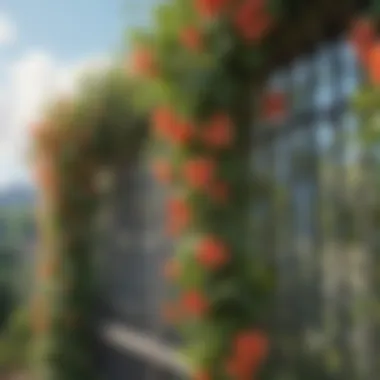Top Flowering Plants Perfect for Your Trellis


Intro
Trellises serve a dual purpose in gardening, providing essential support for climbing plants while also enhancing the visual dynamics of any garden space. Flowering plants, with their various colors and textures, can significantly transform vertical gardens into vibrant displays. This article examines a selection of flowering plants ideal for trellising, analyzing their growth conditions, maintenance needs, and suitability for different garden environments.
Plant Overview
When selecting flowering plants for trellises, gardeners have many factors to consider. The plants must not only be aesthetically pleasing but also capable of thriving within the specific environmental conditions of the garden. Understanding their characteristics is essential for effective gardening practices.
Common Name and Scientific Classification
Various flowering plants can be classified according to their common names and scientific classifications. For example, Clematis is a popular choice, known for its stunning blooms and vigorous climbing ability. Honeysuckle (Lonicera) is another favorite, appreciated for its sweet fragrance and wildlife benefits. Each plant offers unique traits suitable for trellis support.
Physical Characteristics
The physical characteristics of these plants vary significantly. Some may have delicate, small flowers while others bear large, showy blooms. The foliage can also differ, with some plants having evergreen leaves and others being deciduous. Understanding these traits helps in creating a visually harmonious vertical garden.
Habitat and Distribution
Different flowering plants thrive in various habitats. For instance, Wisteria commonly prefers well-drained soil and full sunlight, while Jasminum can grow well in partial shade. Knowing the native distribution of these plants can guide gardeners in making informed decisions about their cultivation techniques.
Growth Requirements
It is essential to consider growth requirements when selecting flowering plants for trellises. Several key factors influence how well a plant performs, including sunlight, soil conditions, and water availability.
Sunlight Needs
Most flowering plants generally prefer full sun, receiving at least six hours of direct sunlight each day. However, species like Ivy or Passionflower adapt better to partial shade conditions.
Soil Conditions
Soil must also be rich in organic matter and well-draining. Heavy clay soils can hinder root development, making it crucial to amend the soil before planting.
Water Requirements
Watering needs vary among plants. While some, like Black-eyed Susan (Rudbeckia), may tolerate drought, others, such as Dragon Flower (Antirrhinum), require consistent moisture.
Maintenance Considerations
Maintaining flowering plants on trellises is vital for their health and longevity. Pruning, fertilizing, and pest management are critical components of their care.
Pruning Techniques
Regular pruning helps to encourage bushy growth and promote blooming. For example, Climbing Roses should be pruned after flowering to manage their size and shape.
Fertilizing Practices
Using a balanced fertilizer can enhance blooming. It is advisable to apply fertilizer in the spring, as the plants begin their growth cycle.
Pest Management
Monitoring for pests is also important. Common pests like aphids or spider mites can hinder plant health. Organic sprays or introducing beneficial insects can aid in pest control.
Prelims to Trellising
In gardening, trellising serves not just as a form of support but also plays a significant role in enhancing the garden's overall appearance. The concept of trellising incorporates various structures designed specifically to aid climbing plants, transforming vertical spaces into delightful visual landscapes. Understanding the fundamentals of trellising is essential for gardeners, whether they are just starting or looking to refine their existing skills.
Defining Trellising
Trellising is the practice of providing a framework for plants to grow. This can include wooden lattices, wire grids, or even more elaborate structures like arbors or pergolas. By guiding plants upward, gardeners can optimize limited ground space, making trellising especially useful in smaller gardens or urban settings. A properly designed trellis not only supports the physical growth of vines and climbers but also allows for better light penetration and air circulation.
Implementing trellises can influence plant growth positively. Using the right materials ensures that plants receive adequate daylight, crucial for their development.
Benefits of Using a Trellis


Utilizing trellises carries several advantages:
- Space Optimization: When plants grow vertically, they take up less horizontal space. This quality is crucial for small gardens.
- Improved Air Circulation: Plants positioned on a trellis benefit from increased airflow, which reduces the risk of fungal diseases.
- Enhanced Sunlight Exposure: Climbing plants positioned on a trellis can receive more sunlight, vital for their growth and flowering.
- Visual Appeal: Aesthetically, trellises can elevate a garden's design. They provide structure and can serve as focal points in garden layouts.
- Easier Maintenance: Plants on trellises are generally easier to prune and harvest. This facilitates better management of plant health and productivity.
“Using a trellis not only amplifies the beauty of your plants but also aids in their overall health and productivity.”
In summary, trellising is an invaluable method that serves multiple purposes in gardening, enhancing both practicality and beauty. Understanding this practice is foundational for successfully implementing flowering plants in vertical spaces, maximizing their potential in your green spaces.
Selecting the Right Flowering Plants
Choosing the right flowering plants for a trellis is a key factor in creating a beautiful and thriving vertical garden. The success of these plants depends on several elements, including climate, soil, and sunlight conditions. Each of these aspects plays a crucial role in the overall health and appearance of the plants. By understanding these factors, gardeners can make informed decisions that lead to more vibrant and successful growth.
Climate Considerations
When selecting flowering plants for your trellis, it is essential to consider the local climate. Different species thrive in various environments. For instance, tropical plants may require warm temperatures year-round, while hardy varieties can endure colder conditions. Researching the hardiness zones in your area can aid in making the right choices.
Plants like Honeysuckle and Clematis are adaptable and can grow in a range of climates, whereas Wisteria needs a temperate climate to flourish fully. Jasmine, on the other hand, prefers warmer and humid conditions. Choosing plants that naturally grow in your climate will enhance their chances of survival and thriving.
Soil Requirements
Soil quality is another critical element when selecting flowering plants for a trellis. Each plant has specific soil needs that determine how well it will grow. For example, Clematis often prefers moist, well-drained soil enriched with organic matter. In contrast, Morning Glory can tolerate poorer soil conditions, adapting easily to various environments.
It is also important to conduct a soil test before planting. This will help to identify pH levels and nutrient content. Many flowering vines will benefit from light amendments like compost or balanced fertilizers. Knowing these requirements allows gardeners to create optimal conditions before planting.
Sunlight Needs
Light exposure is vital for flowering plants, influencing their growth and blooming patterns. Most climbing plants prefer full sun, which means they need at least six hours of direct sunlight daily. For instance, Black-Eyed Susan Vine thrives in sunny spots, producing abundant flowers when given enough light.
In contrast, some species like Jasmine may tolerate partial shade but still perform better with adequate sunlight. Assess the sunlight conditions in your garden before choosing the plants. Pay attention to how shadows from structures or trees may affect light levels. Making the right selection based on light availability will ensure a successful and beautiful trellising display.
Success in growing flowering plants for trellising begins with understanding the specific needs of each species. By focusing on climate, soil, and sunlight, gardeners can create conditions for optimal growth.
By considering these factors, gardeners can successfully select flowering plants for their trellises, resulting in a vertical garden that not only looks good but also flourishes throughout the growing season.
Popular Flowering Climbers
The inclusion of flowering climbers in a trellis system is crucial for enhancing the visual aesthetics of a garden while providing a dynamic vertical element. These plants can turn ordinary structures into vibrant features that attract attention. They also contribute to creating an atmosphere where utility meets beauty. Beyond embellishing personal spaces, flowering climbers can also support native wildlife by providing habitats and food sources. In this section, we will explore several popular flowering climbers that stand out for their growth characteristics, adaptability, and maintenance requirements.
Clematis
Varieties
Clematis is known for its diverse varieties. There are approximately 300 species, which offer a spectrum of colors, sizes, and blooming times. This diversity allows gardeners to select plants that fit their specific tastes and garden designs. Clematis montana, for example, is a vigorous grower with large pink or white flowers. On the other hand, Clematis viticella offers small, richly colored blossoms. This range makes Clematis a favored choice. However, it demands careful selection and placement due to varying growth habits and needs.
Care Tips
Caring for Clematis involves knowledge of their unique requirements. These plants prefer well-draining soil, abundant moisture, and a sunny position to thrive. Additionally, it's important to choose the right pruning method based on the variety, with some needing hard pruning and others less frequent cutting. This knowledge contributes to a robust flowering display. A common mistake is neglecting their need for moisture at the roots while keeping the foliage dry. This can cause problems like wilting or disease.
Honeysuckle
Types
Honeysuckle has many types, including the popular Lonicera japonica. This type is known for its rapid growth and fragrant flowers. Honeysuckle is particularly appealing for trellises due to its ability to cover large areas quickly. The sweet scent of the flowers is another characteristic that attracts gardening enthusiasts. However, some varieties can become invasive, which requires careful attention to prevent uncontrolled spread.
Growth Conditions
Honeysuckle prefers well-draining soil and can adapt to varying sunlight conditions. While it is known to thrive in full sun, it also tolerates partial shade, making it versatile for different garden setups. It's important to keep the soil consistently moist during the growing season, as this will lead to a healthier and more vigorous plant. Neglecting these conditions may cause stunted growth or poor flowering.
Wisteria
Cultivation Guidelines
Wisteria is notable for its cascading clusters of flowers. Successful cultivation requires adequate space and support due to its heavy growth. Wisteria needs full sun and well-drained soil to do well. The key characteristic of this plant is its ability to thrive in nutrient-rich conditions. This means that amending the soil with compost can enhance the growth potential. On the downside, it may take a few years to see significant blooms, which can be an initial drawback for new gardeners.


Maintenance
Wisteria demands regular maintenance, particularly in pruning. Proper pruning is essential to encourage blooming, with specific times needed for effective results. This process requires knowledge to ensure flowers develop in the right season. Additionally, lack of pruning can lead to excessive growth, which detracts from its ornamental value. On the positive side, well-maintained Wisteria can produce spectacular flowers that enhance the garden's appeal.
Jasmine
Usage in Gardens
Jasmine is valued for its fragrant blooms, making it an ideal choice for garden settings where scent is critical. Using Jasmine on trellises can create an inviting atmosphere as the sweet smell wafts through the air. Typically, varieties like Jasminum polyanthum are selected for their rapid growth and fragrant flowers. However, Jasmine may require additional support to climb, which necessitates planning in garden design.
Pruning Techniques
Proper pruning techniques for Jasmine include cutting back after flowering to encourage fresh growth. This ensures that the plant remains manageable and promotes health. The characteristic of Jasmine plants is their ability to flower on new growth. This means pruning is not just maintenance; it is essential for encouraging blooms. However, timing is critical—cuts made too late in the season can reduce flowering potential.
Vines with Unique Attributes
Vines with unique attributes play a crucial role in enhancing vertical gardening. These plants bring not only beauty but also a variety of functions to the garden. Understanding their characteristics, growth habits, and companion plantings informs better garden design and plant selection.
Passionflower
Characteristics
Passionflower is notable for its striking blooms and intricate structure. The plant is usually vigorous, growing rapidly while offering an array of colors in its flowers, ranging from purple to white. One key characteristic of the passionflower is its ability to attract pollinators, particularly bees and butterflies, contributing to a vibrant garden ecosystem. Additionally, this plant is a perennial option, providing returns year after year, which can reduce replanting efforts.
A unique feature is its fruit, known as passion fruit, which adds an additional layer of interest to the garden. However, it can become invasive in some regions, necessitating careful management to prevent it from overtaking other plants.
Culinary Uses
The culinary uses of passionflower extend primarily to its ripe fruit, which is used in beverages and desserts. The fruit is rich in vitamins and has a refreshing flavor, making it a beneficial choice for gardeners interested in both aesthetics and edibility. Its high nutritional value further enhances its appeal, as it can be enjoyed fresh or made into jams and jellies.
One unique feature is that the leaves and flowers are also edible and can be used in herbal teas. However, it's important to note that some parts of the plant may be less palatable and should be approached with caution, ensuring that only suitable parts are consumed.
Black-Eyed Susan Vine
Growth Habits
Black-Eyed Susan Vine exhibits a twining growth habit, which makes it ideal for climbing structures. This plant can quickly cover trellises or fences, creating a vibrant display of yellow and orange blooms. A critical characteristic is its ability to thrive in various conditions, making it adaptable to different growing environments.
The unique feature of this vine is its relatively low maintenance needs. It can flourish in both sunny and partially shaded areas, appealing to gardeners with limited sunlight. However, keep in mind that it requires support to climb effectively, and without it, growth may become unruly.
Companion Planting
Companion planting with Black-Eyed Susan Vine is beneficial for enhancing garden diversity. It grows well alongside more robust plants without overwhelming them, making it an ideal choice for mixed flower beds. The key characteristic of companion planting is that it can help improve pest control and promote healthier plant growth.
A unique feature is the attraction of beneficial insects when planted with other flowering species. This trait can help create a balanced ecosystem in the garden. However, ensure to plan for space and light requirements of nearby plants to optimize growth.
Morning Glory
Varieties
Morning Glory encompasses a wide range of species and varieties, from the common Ipomoea purpurea to the more exotic cultivars. Each variety displays distinct colors and shapes in its blossoms, which can add layers of visual interest to your garden. A primary characteristic of Morning Glory is its rapid growth, often blooming in just a matter of weeks after planting.
The uniqueness of different varieties offers extensive possibilities for customization in garden design. However, some varieties can become invasive, so careful selection and management are vital.
Flowering Season
Morning Glory typically flowers from late spring to early fall, making it an excellent choice for continuous color throughout the growing season. The key characteristic of its flowering season is that blooms open in the morning and close by afternoon, usually lasting only a day. This daily cycle creates a dynamic visual effect in the garden.
A unique feature is the potential for prolonged flowering with proper care, including regular watering and fertilizing. Yet, gardeners should be prepared for the need to control growth, as it can become overly ambitious if left unchecked. Proper timing and maintenance ensure that the beauty of Morning Glory can be fully realized.
Flowering Plants for Small Spaces
In urban gardening or smaller landscapes, maximizing space is crucial. Selecting flowering plants that thrive in limited areas enhances not only the aesthetic appeal but also adds variety and life to these spaces. These plants enable gardeners to cultivate vertical gardens that can compensate for the lack of ground area. By utilizing trellises, even the smallest gardens can become vibrant and lush, showcasing color and beauty.


Sweet Peas
Growing Conditions
Sweet peas are lovely annuals that enjoy a cool growing environment. They thrive best in well-drained, fertile soil. The soil should be rich in organic matter to sustain their growth. These plants can handle partial shade but will flourish in full sun. This adaptability makes them a beneficial choice for those with varying light conditions in smaller gardens. Additionally, they need consistent moisture, so regular watering is essential, especially during dry spells. However, attention must also be paid to avoid waterlogging, which can be detrimental to their growth.
Aesthetic Appeal
Sweet peas are known for their charming, fragrant flowers that come in a spectrum of colors. Their delightful scent enhances not only the visual but also the sensory experience in gardens. They can be trained up trellises, which makes them perfect for vertical gardening. Their climbing nature fosters an enchanting atmosphere, allowing narrow spaces to feel fuller and more inviting. The seasonal blooming adds a dynamic color palette to any garden, presenting beauty from spring to autumn. However, it is important to note that their blooms are transient, requiring regular harvesting to encourage continuous flowering.
Scarlett Runner Bean
Edible Aspects
The Scarlett Runner Bean stands out for its dual purpose—ornamental and edible. It produces striking red flowers and yield edible beans, making it practical for gardens where space and utility are factors. The young pods can be harvested and eaten, providing a fresh component to meals. This versatility makes it a favored choice. However, these beans need support to grow, so effective trellising is needed.
Growing Tips
When growing Scarlett Runner Beans, choose a sunny location, as they thrive in warm conditions. They should be planted after the last frost to avoid cold damage. It’s crucial to provide ample water during their growth stage to ensure healthy beans and blooms. Regular monitoring can prevent pest issues, ensuring the plants stay vigorous. It's vital to remember that over-fertilizing can lead to lush foliage at the expense of blooms and beans, so balance is key.
Timing and Maintenance
The proper timing and consistent maintenance of flowering plants on trellises are crucial for achieving healthy growth and vibrant blooms. Understanding when to plant, prune, and fertilize significantly affects the plant's overall health and productivity. It also impacts blooming times, which can enhance the visual appeal of a vertical garden when timed correctly.
Planting Seasons
Choosing the right time for planting is key. Most flowering climbers flourish when planted in spring after the last frost. This timing allows them to establish roots before the heat of summer arrives. However, some varieties, like certain species of Jasmine or Wisteria, can also be planted in the fall in milder climates. For gardeners, it's essential to check local climate conditions to decide on the best timing.
The following points may assist gardeners in selecting the right planting season:
- Understanding Frost Dates: Knowing the last expected frost date in your area ensures that plants are not exposed to cold conditions.
- Consideration of Bloom Time: Different plants have varied blooming periods. Planning accordingly allows for a staggered visual effect in your garden.
- Soil Temperature: Warmer soils encourage faster root development, thus promoting stronger plant growth.
Pruning Techniques
Pruning is an integral part of plant care that cultivates both health and aesthetics. Regular pruning helps in controlling plant size, encouraging new growth, and removing dead or diseased branches. It is usually recommended to prune flowering climbers just before their growing season in early spring. However, specific species may require different pruning times.
Here are a few key points regarding pruning:
- Timing: Most flowering vines should be pruned early in spring for fresh growth.
- Proper Tools: Using sharp, clean tools minimizes damage to the plants and helps prevent disease.
- Technique: Cut back to a strong bud, recognizing that different climbing plants may need distinct approaches.
Pruning effectively can maximize the blooming potential of flowering plants, ensuring a prolific display.
Fertilization Practices
Fertilization is essential to provide the nutrients that flowering plants require for robust growth. When using a trellis, plants might have increased needs due to their vertical growth. Ideally, fertilization should begin in early spring as the plants start to grow actively.
Here are some practices to consider:
- Types of Fertilizers: Slow-release fertilizers or organic options can provide steady nutrients over time. Liquid fertilizers may also be applied during the growing season for an immediate boost.
- Frequency: Generally, fertilizing every 4-6 weeks during the growing season benefits flowering plants. Over-fertilization can harm plants, so timing and amounts are key.
- pH Levels: Knowing the soil's pH can help determine if specific adjustments are needed to optimize nutrient availability.
In summary, meticulous attention to timing and maintenance aspects such as planting seasons, pruning techniques, and fertilization can elevate the success of flowering plants on trellises. These practices not only enhance visual appeal but also contribute to the well-being of each plant, ensuring a flourishing garden.
The End
The topic of utilizing flowering plants for trellises holds significant importance in gardening. This article has explored various flowering climbers and unique vines that can enhance not only the aesthetic appeal of gardens but also their structural integrity. By integrating these plants, gardeners can transform vertical spaces into lush environments.
Understanding the specific growth requirements and benefits of each plant ensures that selections complement local climates and soil types. Such knowledge helps avoid common pitfalls, fostering a thriving garden where plants not only survive but thrive.
Additionally, a well-designed vertical garden can yield environmental benefits. It creates habitats for local wildlife, contributing positively to local biodiversity. Therefore, selecting appropriate flowering plants for trellising is not just about beautification; it is also a responsible approach to horticulture that embraces ecological balance.
"Gardening is not just about plants; it's about creating ecosystems."
Recap of Key Points
- Trellis Systems: Provide support for climbing plants, enhancing spatial efficiency.
- Plant Selection: Depends on climate, soil quality, and sunlight availability.
- Popular Varieties: Plants like clematis, honeysuckle, and jasmine offer unique beauty and growth benefits.
- Unique Attributes: Vines like passionflower and black-eyed Susan add distinct features to gardens.
- Maintenance: Proper timing for planting, pruning, and fertilization significantly affect plant health.
Encouragement for Exploration
Plants can be a rewarding exploration, moving beyond just basic varieties. Engaging with local nurseries, attending gardening workshops, or joining online communities can enrich your gardening experience. For instance, platforms like reddit.com provide forums for gardeners to share insights, tips, and personal experiences.
This exploration encourages a deeper connection with nature and fosters greater respect for the environment.
As you plan your trellis, consider experimenting with plants that align with both your personal taste and the ecological needs of your area. The world of trellising is ripe for creativity and discovery, promising not just a garden, but a legacy of natural beauty.







